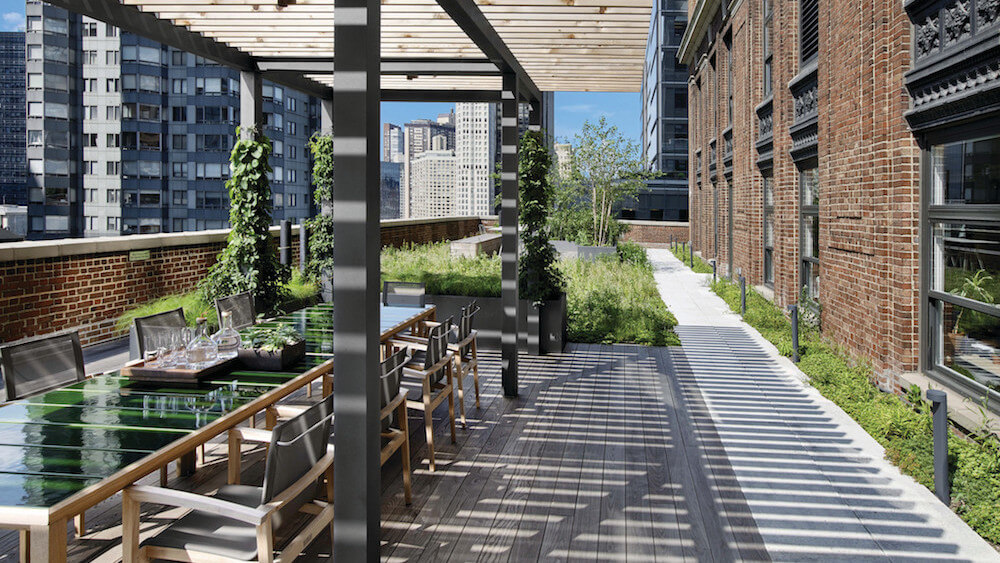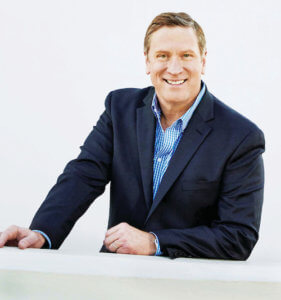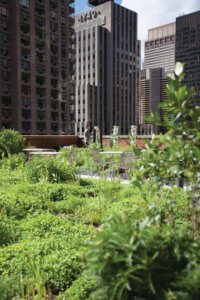
The terrace at COOKFOX. (Photo by Eric Laigne)
The intersection of Broadway and West 57th Street in midtown Manhattan is one of the busiest neighborhoods in New York City — at most hours of the day, the streets are congested with noisy buses, trucks, and cars, and the sidewalks are filled with quick-moving pedestrians.
But on a Tuesday afternoon in early September, as I stood 17 floors above the pavement, the word that kept coming to mind was “bucolic.” On a terrace at the offices of COOKFOX architects, I watched as bees buzzed lazily around an apiary in the corner of a lightly cultivated garden. The air smelled faintly of mint and grass, and the last of the summer’s cherry tomatoes added tiny pops of color.
The connection to nature didn’t end when I stepped back indoors: There was a long wooden table, where employees gather to work or share a meal, situated on a cool expanse of floor that looked like stone. Light filtered in through tall windows, and through the glass doors that opened up on yet another sun-dappled terrace at the other end of the office. There were plants everywhere — in terrariums in the foyer, in big pots on the floor, on shelves and dividers, and at every desk.
It felt good just to be there — which was exactly the point. COOKFOX, a pioneer in designing buildings which meet the certification standards set by the U.S.
Green Building Council’s (USGBC) LEED program, is also an early adopter of the WELL building standards, the world’s first building standard focused exclusively on the health and well-being of building occupants. The office was awarded LEED Platinum, the highest ranking in the USGBC program, but the five-year-old WELL standard measures something more, Jared Gilbert, director of communications for COOKFOX, said: the effect that buildings have on the humans who use them.
‘Intrinsically Linked’

Rick Fedrizzi
The office of the International WELL Building Institute (IWBI), where Rick Fedrizzi is chairman and CEO, is only a few miles away, in a historic building in Manhattan’s Flatiron District. Also WELL gold certified, the space shares many of the same features, minus the terraces, as COOKFOX’s office — the architecture firm designed the IWBI interiors as a pro bono project.
The first wave of sustainability — including the adoption of LEED and other green building standards — “was the focus on planetary health,” said Fedrizzi, over a glass of sparkling water in the Institute’s conference room. “The second wave of sustainability is focused on human health, because those two are intrinsically linked. You can’t separate humans from the planet, or vice versa.”
Fedrizzi is in a unique position to describe the links between LEED — which stands for Leadership in Energy and Environmental Design — and the WELL standards. Before he became chairman of IWBI in 2016, Fedrizzi was the founding chair of USGBC, which created the LEED certification, and served as CEO for 15 years. During his tenure, LEED, which was launched in 1993, grew to be the most widely used green building standard in the world, with more than 80,000 projects, including 60 convention centers, participating in LEED in 162 countries.
By comparison, the WELL building standards — which are two decades behind the LEED initiative — are being applied in 3,782 projects across 58 countries. “It’s important to set the baseline of the conversation,” Fedrizzi said. The reason we now “have the luxury of looking at human health on a microscopic level related to real estate, is because USGBC and LEED have done such a great job looking at the macro or planetary health [level],” he said, including “looking at buildings, cities, and convention centers from the standpoint of, ‘What can we do to minimize energy, water, waste, materials, toxins?’ You now create a level playing field where the human being actually has a chance to be in a healthier setting, and where the ability to look deeper into things that affect humans is now front and center.”

Honey, herbs, and vegetables are harvested from kitchen garden planted at COOKFOX’s office in New York City. (Photo by Eric Laigne)
The bees and the textured surfaces at the COOKFOX office caught my eye — the firm specializes in biophilic design, the use of natural elements to evoke positive biological responses — but the WELL standards operate at multiple levels, mostly not visible. There are seven concepts in the standards — air, water, light, comfort, nourishment, fitness, and mind — each accompanied by research into how they support well-being.
At COOKFOX, for example, employees were working and talking quietly in the office, the calm aided, Gilbert said, by the installation of sound dampening pads. All of the desks are within 20 feet of a window, and the office lighting system — it has 16 different zones, Gilbert told me — suppresses blue light to promote healthy circadian rhythm. CO2 sensors continuously monitor the quality of the air. A shower available to employees helps encourage breaks for a bicycle ride or a run, and space outside is used for group exercise. At the IWBI offices, a clear glass-fronted refrigerator in the kitchen displays fresh fruit and vegetables, so that employees are likely to reach for them first.
Kicking the Tires on WELL
The focus on buildings as a way of improving human health makes sense, because “we’re in buildings more than 90 percent of our lives,” Fedrizzi said. “We like to think we’re all outdoorsy people that kayak and run races and do all those great things, but if you actually do the math on how many hours a day you are in a building. … All of those indoor spaces are places that are either going to nurture a human being or be hugely offensive to their ability to perform.”
In Fedrizzi’s view, most convention centers typically have fallen in the non-nurturing category. “I have been in thousands of meeting rooms and convention centers, over the years. And I would say the great majority of them are — dismal, I think is the best word I can use,” he said. “The lack of lighting, the toxic smells of, almost always formaldehyde, is probably the No. 1 culprit.”
Fedrizzi predicts that the demand for WELL-certified convention centers will grow in the same way that the LEED-certified green building program did — through exposure. “That’s really how green building began,” he said. “There were no good examples of it until there were two or three buildings here in New York City that people could visit and kick the tires.”
Planners are “very boots on the ground kinds of people,” Fedrizzi said. “They probably know already where the best convention centers are, not only from an amenities standpoint and proximity to community restaurants, and shops, and everything else, but they probably know the ones that just feel good, where the sun is always shining, where they actually have fresh air blowing through the place. And those are things that they probably just know — but don’t necessarily know that that is something that can actually be duplicated from city to city in convention centers.”
For Fedrizzi, building a bridge from USGBC to the IWBI may create “one of the most powerful statements ever,” he said, “which is this collaborative moment on Earth where we bring our focus on the planet and our focus on the people together.” If we know how to create environments “where people learn better, feel better, and have less stress,” Gilbert said, “we have to do it.”
- Find out more about the International WELL Building Institute and WELL at wellcertified.com, and Convene’s March 2019 story, “Buildings Designed for Comfort, Joy, Human Performance.”
- Learn more about the World Obesity Federation’s Healthy Venues accreditation at worldobesity.org/what-we-do/projects/healthy-venu
